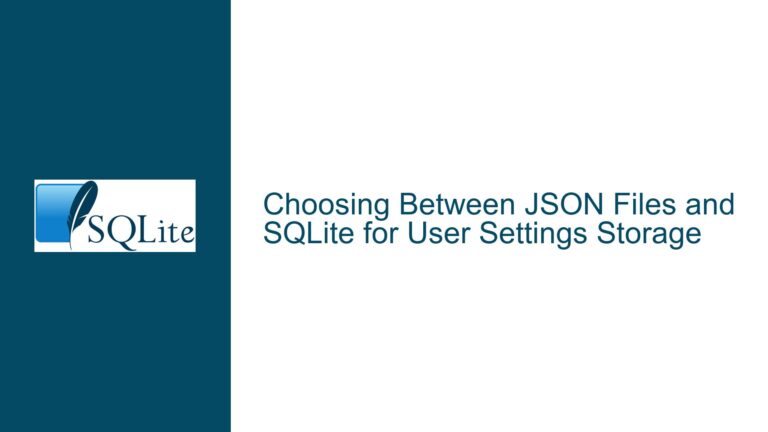Starting SQLite INTEGER PRIMARY KEY from 0 Instead of 1
SQLite INTEGER PRIMARY KEY Defaults to 1 Instead of 0
When using SQLite, a common requirement is to have an INTEGER PRIMARY KEY column that auto-increments starting from 0. However, SQLite’s default behavior is to start the auto-incrementing value from 1. This behavior is documented and is a result of SQLite’s internal implementation. The issue arises when developers need the primary key to start from 0, particularly in scenarios where the primary key is used as an index in a zero-based system, such as in programming languages like C or Python.
The INTEGER PRIMARY KEY in SQLite is a special type of column that automatically assigns a unique integer value to each row. When a new row is inserted and the INTEGER PRIMARY KEY column is set to NULL, SQLite assigns the next available integer value. By default, this value starts at 1. This behavior is consistent across all SQLite databases and is not configurable through standard SQLite commands or pragmas.
The challenge arises when the application logic requires the primary key to start from 0. This is particularly common in systems where the primary key is used as an index in a zero-based array or list. For example, if the primary key is used to reference elements in an array, starting from 1 could lead to off-by-one errors, which are a common source of bugs in software development.
Interrupted Write Operations Leading to Index Corruption
The default behavior of SQLite’s INTEGER PRIMARY KEY starting from 1 is deeply ingrained in its design. The primary key is used internally by SQLite to uniquely identify rows within a table. The value of the primary key is stored in the database file, and changing the starting value could have implications for the internal consistency of the database.
One of the reasons SQLite starts the primary key from 1 is to ensure that the value is always positive. SQLite uses a 64-bit signed integer to store the primary key, and starting from 1 ensures that the value is always within the positive range. This is important because negative values could lead to unexpected behavior in certain operations, such as sorting or indexing.
Another reason for starting from 1 is historical. SQLite has been around for over two decades, and the behavior of starting the primary key from 1 has been consistent throughout its history. Changing this behavior could break existing applications that rely on this default behavior. For example, some applications might assume that the first row inserted into a table will always have a primary key of 1. Changing this behavior could lead to subtle bugs in these applications.
The use of the sqlite_sequence table, which is used to track the next available value for AUTOINCREMENT columns, does not apply to INTEGER PRIMARY KEY columns that are not explicitly declared as AUTOINCREMENT. This means that there is no built-in mechanism to change the starting value of the primary key for tables that use INTEGER PRIMARY KEY without AUTOINCREMENT.
Implementing Virtual Columns and Triggers for Zero-Based Indexing
To achieve a zero-based primary key in SQLite, developers can use a combination of virtual columns and triggers. Virtual columns are columns whose values are computed at runtime rather than being stored in the database. Triggers are database objects that automatically execute a specified set of actions when certain events occur, such as inserting a new row into a table.
One approach is to use a virtual column to compute the zero-based index. This can be done by defining a generated column that subtracts 1 from the INTEGER PRIMARY KEY. For example:
CREATE TABLE t2(
pk INTEGER PRIMARY KEY,
id INT GENERATED ALWAYS AS (pk-1) STORED UNIQUE
);
In this example, the id column is a generated column that always contains the value of pk-1. When a new row is inserted into the table, the pk column is automatically assigned a value starting from 1, and the id column is computed as pk-1, resulting in a zero-based index.
Another approach is to use an AFTER INSERT trigger to update the primary key value after a new row is inserted. For example:
CREATE TABLE t1(
id INT PRIMARY KEY
);
CREATE TRIGGER t1_id AFTER INSERT ON t1 BEGIN
UPDATE t1 SET id = rowid-1 WHERE rowid = new.rowid;
END;
In this example, the trigger updates the id column to be rowid-1 after a new row is inserted. The rowid is an internal identifier used by SQLite to uniquely identify rows within a table. By subtracting 1 from the rowid, the id column is effectively zero-based.
Both of these approaches allow developers to achieve a zero-based primary key in SQLite without modifying the SQLite source code. However, they come with some trade-offs. Using virtual columns can increase the complexity of the schema and may have performance implications, especially for large tables. Using triggers can also add overhead to insert operations, as the trigger must be executed for each new row.
For developers who are comfortable with modifying the SQLite source code, it is possible to change the default starting value of the primary key by applying a patch to the SQLite source code. The patch modifies the vdbe.c file to change the initial value of the primary key from 1 to 0. However, this approach is not recommended for most users, as it requires recompiling SQLite and could lead to compatibility issues with existing applications.
In conclusion, while SQLite does not natively support starting the INTEGER PRIMARY KEY from 0, there are several workarounds available. Developers can use virtual columns or triggers to achieve a zero-based index, or they can modify the SQLite source code to change the default behavior. Each approach has its own trade-offs, and the best solution depends on the specific requirements of the application.






